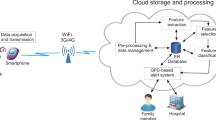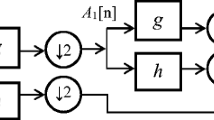Abstract
In this paper, we present an epilepsy analysis system, referred to as EAS, for long-term electroencephalography (EEG) monitoring of patients with epilepsy. In our previous works, a high accuracy seizure detection algorithm had been devised. Six support vector machines (SVMs) had been trained to collaboratively classify EEG data into four types, i.e., normal, spike, sharp wave, and seizure. The EAS had initially extracted a total of 980 features from raw EEG data of patients, and then, for each SVM, it used a naïve genetic algorithm (GA) to determine a feature subset of the 980 features. However, the feature subsets still included some low-impact features for the EEG classification, and the training process of the seizure detector was time consuming. In this study, the GA is enhanced to further exclude low-impact features from the feature subsets and MapReduce parallel processing is adopted to speed up the training process. In the experiment, a 363-h clinical EEG records were acquired from 28 participants, 3 of which were normal, and 25 were patients with epilepsy. The experiment results show that average size of the feature subsets is reduced from 133.5 to 92.5 and the overall classification accuracy increases from 88.8 to 90.1 %. The new seizure detector processes a 10-s EEG record within 0.6 s, meaning that it meets the real-time requirement for online EEG monitoring gracefully. When the number of servers increases from 1 to 15, the training time of the detector is reduced from 38.3 to 4.9 h. Our new approach improves the EAS significantly.









Similar content being viewed by others
References
Al-Kasasbeh RT, Shamasin MS, Skopin DE (2008) Automated detection and selection of artifacts in encephalography signals. Med Tekh 42:19–26
Beltrachini L, Ellenrieder N, Muravchik CH (2013) Shrinkage approach for spatiotemporal EEG covariance matrix estimation. IEEE Trans Signal Process 61(7):1797–1808
Boer HM, Mula M, Sander JW (2008) The global burden and stigma of epilepsy. Epilepsy Behav 12(4):540–546
Butterworth S (1930) On the theory of filter amplifiers. Exp Wirel 7:536–541
Chang CC, Lin CJ (2011) LIBSVM: a library for support vector machines. ACM Trans Intell Syst Technol 2(3). doi:10.1145/1961189.1961199. The software is available at http://www.csie.ntu.edu.tw/~cjlin/libsvm
Chen L, Luo W, Zhen YD, Zeng S (2009) Characterizing the complexity of spontaneous electrical signals in cultures neuronal networks using approximate entropy. IEEE Trans Inf Technol Biomed 13:405–410
Chen W, Shen CP, Chiu MJ, Zhao Q, Cichocki A, Lin JW, Lai F (2015) Epileptic EEG visualization and sonification based on linear discriminate analysis. In: 37th annual international conference of IEEE engineering in medicine and biology society, Milano, Italy, pp 4466–4469
Cortes C, Vapnik V (1995) Support-vector network. Mach Learn 20(3):273–297
Cragar DE, Berry DTR, Fakhoury TA, Cibula JE, Schmitt FA (2002) A review of diagnostic techniques in the differential diagnosis of epileptic and non-epileptic seizures. Neuropsychol Rev 12(1):31–64
Daubechies I (1990) The wavelet transform, time-frequency localization and signal analysis. IEEE Trans Inf Theory 36(5):961–1005
Delorme A, Sejnowski T, Makeigb S (2007) Enhanced detection of artifacts in EEG data using higher-order statistics and independent component analysis. NeuroImage 34:1443–1449
DeVos M, Deburchgraeve W, Cherian PJ, Matic V, Swarte RM, Visser GH, VanHuffel S (2011) Automated artifact removals preprocessing refines neonatal seizure detection. J Clin Neurophysiol 122(12):2345–2354
Ghosh-Dastidar S, Adeli H (2008) Principle component analysis enhanced cosine radial basis function neural network for robust epilepsy and seizure detection. IEEE Trans Biomed Eng 55(2):512–518
Halforda JJ, Schalkoffb RJ, Zhoub J, Benbadisc SR, Tatumd WO, Turnera RP, Sinhae SR, Fountainf NB, Araing A, Pritcharda PB, Kutluaya E, Martza G, Edwardsa JC, Watersh C, Deanh BC (2013) Standardized database development for EEG epileptiform transient detection: EEGnet scoring system and machine learning analysis. J Neurosci Methods 212(2):308–316
Holland JH (1992) Adaptation in natural and artificial systems: an introductory analysis with applications to biology, control, and artificial intelligence. MIT Press, Cambridge
Hsieh SH, Cheng PH, Chen CH, Huang KH, Chen PH (2010) A newborn screening system based on service-oriented architecture embedded support vector machine. J Med Syst 34(4):727–733
Kao WC, Chen WH, Yu CK, Hong CM, Lin SY (2005) Portable real-time homecare system design with digital camera platform. IEEE Trans Consum Electron 5(4):1035–1041
Lucia M, Fritschy J, Dayan P, Holder D (2008) A novel method for automated classification of epileptiform activity in the human electroencephalogram-based on independent component analysis. Med Biol Eng Comput 46:263–272
Mallat S (1989) A theory for multiresolution signal decomposition: the wavelet presentation. IEEE Trans Intell 11(7):674–693
Niedermeyer E, Silva FL (2004) Electroencephalography: basic principles, clinical applications, and related fields. Lippincott Williams & Wilkins, Philadelphia. ISBN: 0-7817-5126-8
Ogiela L, Ogiela MR (2011) Semantic analysis processes in advanced pattern understanding systems. In: Kim TH et al (eds) Communications in computer and information science, vol 195. Springer, Berlin, pp 26–30
Perronnin F, Dance C (2007) Fisher kernels on visual vocabularies for image categorization. In: IEEE conference on computer vision and pattern recognition, pp 1–8
Shen CP, Chen CC, Hsieh SL, Chen WH, Chen JM, Chen CM, Lai F, Chiu MJ (2013a) High-performance seizure detection system using a wavelet-approximate entropy-fSVM cascade with clinical validation. Clin EEG Neurosci. doi:10.1177/1550059413483451
Shen CP, Kao WC, Yang YY, Hsu MC, Wu YT, Lai F (2012) Detection of cardiac arrhythmia in electrocardiograms using adaptive feature extraction and modified support vector machines. Expert Syst Appl 39(9):556–561
Shen CP, Liu CH, Lin FS, Lin H, Huang CYF, Kao CY, Lai F, Lin JW (2012) A multiclass classification tool using cloud computing architecture. In: International symposium on network enabled health informatics, biomedicine and bioinformatics, Istanbul, Turkey, pp 797–802
Shen CP, Liu ST, Zhou W, Lin FS, Lam YY, Sung HY, Chen W, Lin JW, Chiu MJ, Pan MK, Kao JH, Wu JM, Lai F (2013b) A physiology-based seizure detection system for multichannel EEG. PLOS One 8(6). doi:10.1371/journal.pone.0065862
Temko A, Marnane W, Boylan G, Lightbody G (2015) Clinical implementation of a neonatal seizure detection algorithm. Decis Support Syst 70:86–96
Tsai MH, Chen MY, Huang SG, Hung YC, Wang HC (2015) A bio-inspired computing model for ovarian carcinoma classification and oncogene detection. Bioinformatics 31(7). doi:10.1093/bioinformatics/btu782
Tzallas AT, Tsipouras MG, Fotiadis DI (2009) Epileptic seizure detection in EEGs using time frequency analysis. IEEE Trans Inf Technol Biomed 13(5):703–710
Übeyli ED, Güler I (2007) Features extracted by eigenvector methods for detecting variability of EEG signals. Pattern Recognit Lett 28(5):592–603
Weng W, Khorasani K (1996) An adaptive structure neural network with application to EEG automatic seizure detection. Neural Netw 9:1223–1240
Yadav R, Swamy M, Agarwal R (2012) Model-based seizure detection for intracranial EEG recordings. IEEE Trans Biomed Eng 59:1419–1428
Author information
Authors and Affiliations
Corresponding author
Ethics declarations
Conflict of interest
None.
Additional information
Communicated by V. Loia.
Rights and permissions
About this article
Cite this article
Shen, CP., Lin, JW., Lin, FS. et al. GA-SVM modeling of multiclass seizure detector in epilepsy analysis system using cloud computing. Soft Comput 21, 2139–2149 (2017). https://doi.org/10.1007/s00500-015-1917-9
Published:
Issue Date:
DOI: https://doi.org/10.1007/s00500-015-1917-9




